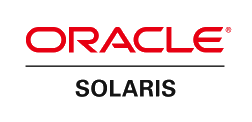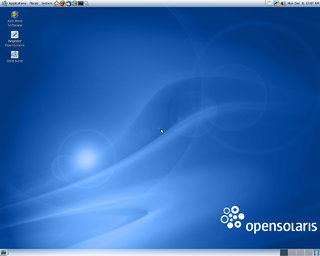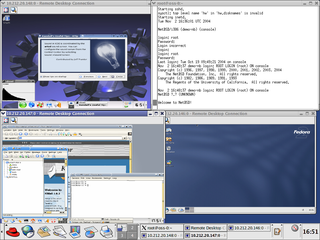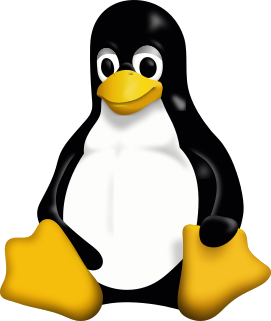
StarOffice, known briefly as Oracle Open Office before being discontinued in 2011, was a proprietary office suite. It originated in 1985 as StarWriter by Star Division, which was acquired by Sun Microsystems in 1999. Sun Microsystems, in turn, was acquired by Oracle Corporation in 2010.
A hypervisor or virtual machine monitor (VMM) is computer software, firmware or hardware that creates and runs virtual machines. A computer on which a hypervisor runs one or more virtual machines is called a host machine, and each virtual machine is called a guest machine. The hypervisor presents the guest operating systems with a virtual operating platform and manages the execution of the guest operating systems. Multiple instances of a variety of operating systems may share the virtualized hardware resources: for example, Linux, Windows, and macOS instances can all run on a single physical x86 machine. This contrasts with operating-system-level virtualization, where all instances must share a single kernel, though the guest operating systems can differ in user space, such as different Linux distributions with the same kernel.
In computing, para-virtualization is a virtualization technique that presents a software interface to the virtual machines which is similar, yet not identical to the underlying hardware–software interface.
Platform virtualization software, specifically emulators and hypervisors, are software packages that emulate the whole physical computer machine, often providing multiple virtual machines on one physical platform. The table below compares basic information about platform virtualization hypervisors.
HotSpot, released as Java HotSpot Performance Engine, is a Java virtual machine for desktop and server computers, maintained and distributed by Oracle Corporation. It features improved performance via methods such as just-in-time compilation and adaptive optimization.
Virtual Iron Software, was located in Lowell, Massachusetts, sold proprietary software for virtualization and management of a virtual infrastructure. Co-founded by Alex Vasilevsky, Virtual Iron figured among the first companies to offer virtualization software to fully support Intel VT-x and AMD-V hardware-assisted virtualization.

Oracle VM VirtualBox is a free and open-source hosted hypervisor for x86 virtualization, developed by Oracle Corporation. Created by Innotek GmbH, it was acquired by Sun Microsystems in 2008, which was, in turn, acquired by Oracle in 2010.
Logical Domains is the server virtualization and partitioning technology for SPARC V9 processors. It was first released by Sun Microsystems in April 2007. After the Oracle acquisition of Sun in January 2010, the product has been re-branded as Oracle VM Server for SPARC from version 2.0 onwards.
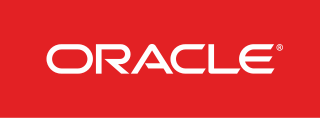
Oracle VM Server for x86 is the server virtualization offering from Oracle Corporation. Oracle VM Server for x86 incorporates the free and open-source Xen hypervisor technology, supports Windows, Linux, and Solaris guests and includes an integrated Web based management console. Oracle VM Server for x86 features fully tested and certified Oracle Applications stack in an enterprise virtualization environment.
Live migration refers to the process of moving a running virtual machine or application between different physical machines without disconnecting the client or application. Memory, storage, and network connectivity of the virtual machine are transferred from the original guest machine to the destination.

libvirt is an open-source API, daemon and management tool for managing platform virtualization. It can be used to manage KVM, Xen, VMware ESXi, QEMU and other virtualization technologies. These APIs are widely used in the orchestration layer of hypervisors in the development of a cloud-based solution.
Oracle Enterprise Manager Ops Center is a data center automation tool that simplifies discovery and management of physical and virtualized assets. Among its features it can:
Oracle Virtual Desktop Infrastructure (VDI) software is a desktop virtualization product that provides desktop virtualization to replace personal computers with virtual machines (VMs) on a server. Desktops are accessed via Sun Ray Client, Oracle VDC Client (basically a software version of the Sun Ray, also using the same ALP protocol as the Sun Ray, Remote Desktop Protocol client, or optionally through the web via Oracle Secure Global Desktop software.
In computing, a system virtual machine is a virtual machine provides a complete system platform which supports the execution of a complete operating system (OS). These usually emulate an existing architecture, and are built with the purpose of either providing a platform to run programs where the real hardware is not available for use, or of having multiple instances of virtual machines leading to more efficient use of computing resources, both in terms of energy consumption and cost effectiveness, or both. A VM was originally defined by Popek and Goldberg as "an efficient, isolated duplicate of a real machine".


